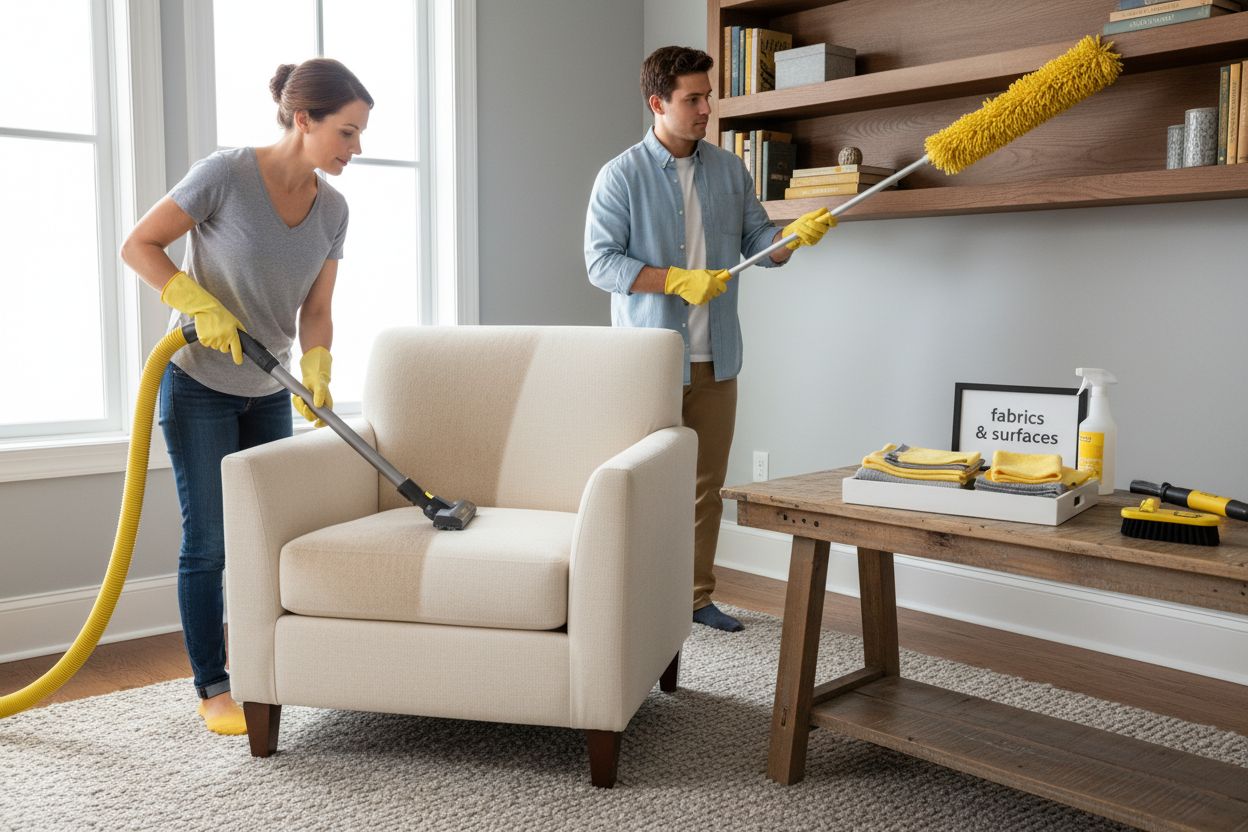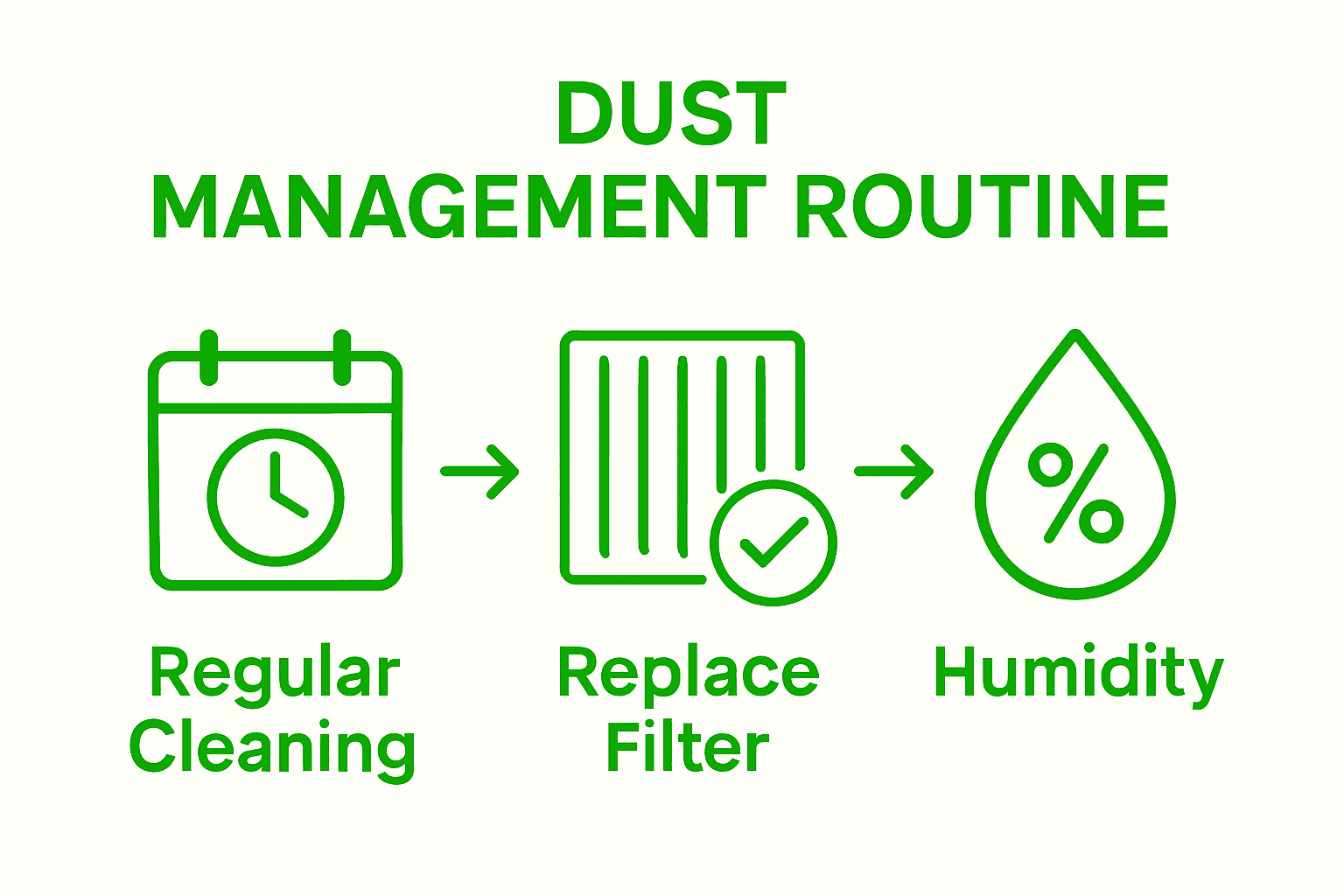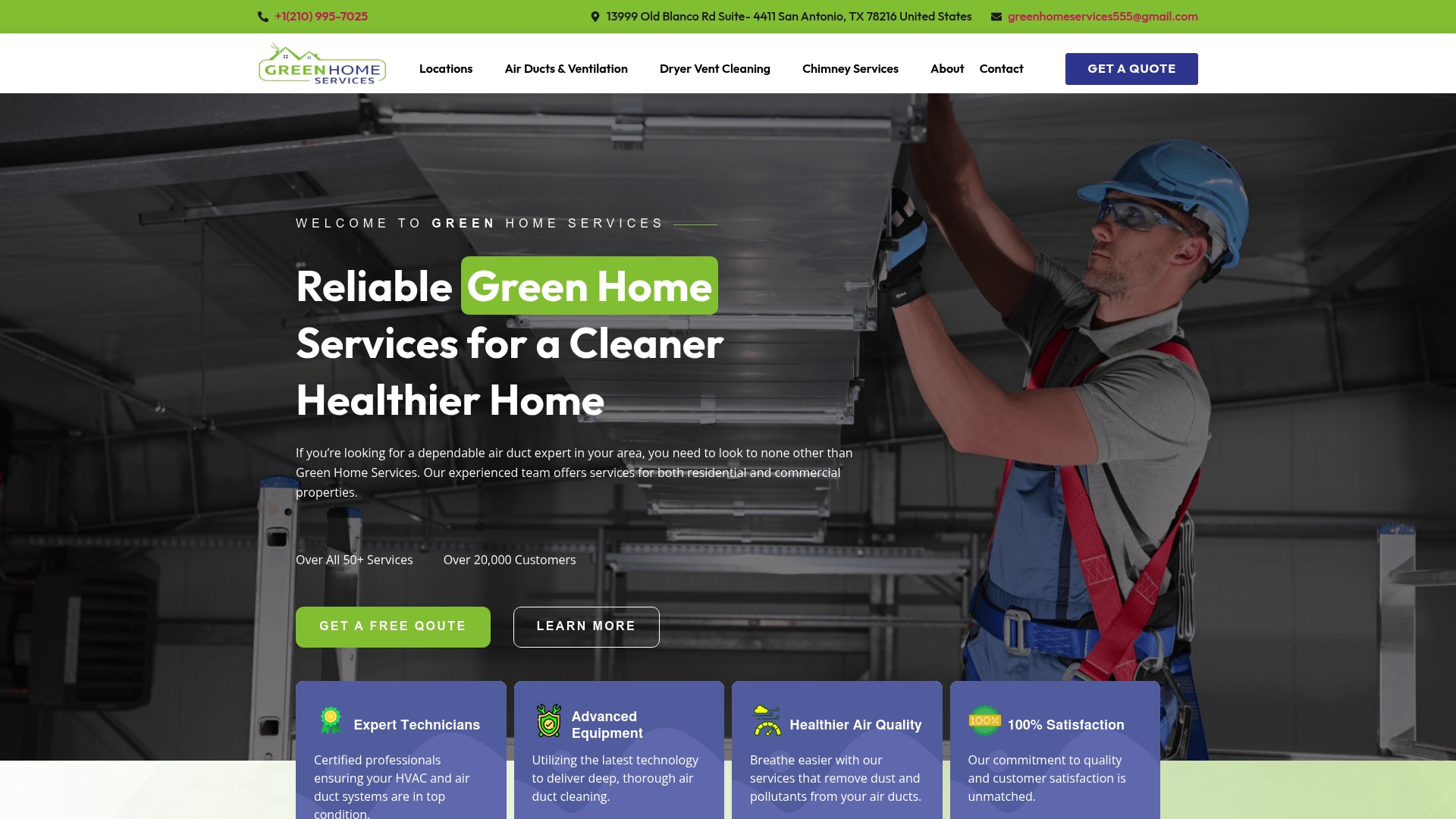Dust seems to appear out of nowhere and settle everywhere no matter how often you clean. Some homes gather dust faster than others and the reason might surprise you. Fabric surfaces like carpets, curtains, and upholstered furniture can trap huge amounts of dust, making them top dust reservoirs in your home. What really turns the tables is that small shifts in your cleaning habits and a few smart tools can actually change how quickly dust returns. Ready to see what makes the biggest difference?
Table of Contents
- Step 1: Assess Your Home Environment For Dust Sources
- Step 2: Gather Appropriate Cleaning Tools And Supplies
- Step 3: Implement Dust Removal Techniques In Key Areas
- Step 4: Enhance Air Quality Through Regular Maintenance
- Step 5: Monitor And Evaluate Dust Levels Over Time
Quick Summary
| Key Point | Explanation |
|---|---|
| 1. Regularly assess dust sources | Conduct systematic inspections in high traffic areas to identify where dust builds up most rapidly. |
| 2. Use proper cleaning tools | High-quality microfiber cloths and HEPA vacuums are essential for effective dust removal. |
| 3. Implement strategic cleaning techniques | Clean from top to bottom, focusing on high dust accumulation zones to prevent re-depositing dust. |
| 4. Maintain air quality | Replace HVAC filters regularly and control humidity levels to reduce dust and allergens. |
| 5. Monitor dust levels over time | Track dust accumulation using consistent methods to refine cleaning strategies and gauge effectiveness. |
Step 1: Assess Your Home Environment for Dust Sources
Reducing dust buildup starts with understanding where dust originates in your home. Most homeowners underestimate the complexity of dust accumulation, but a strategic assessment can dramatically improve indoor air quality. Learn more about comprehensive dust control for a cleaner living environment.
Begin your dust assessment by conducting a systematic walkthrough of your home. Start in high traffic areas like living rooms and bedrooms where dust tends to collect rapidly. Look for visible dust accumulation on surfaces such as shelves, electronics, window sills, and floor edges. Pay special attention to areas near air vents, ceiling fans, and baseboards, which are prime dust collection zones.
Your assessment should include identifying potential dust sources. Fabric surfaces like carpets, curtains, upholstered furniture, and bedding are significant dust reservoirs. Check these areas carefully, noting how quickly dust settles. Consider the materials in your home older carpets, heavy drapes, and vintage furniture tend to trap more dust compared to smoother, more modern surfaces.
Take note of your household composition as well. Pets, number of residents, and lifestyle factors dramatically influence dust generation. Homes with multiple people, pets, or those located near construction sites or busy roads will accumulate dust more quickly. Check out our air duct inspection guide to understand how your home’s unique characteristics impact dust buildup.
To verify the effectiveness of your initial assessment, use the following criteria:
- Surfaces remain visibly clean for longer periods
- Less frequent dusting is required
- Reduced respiratory irritation or allergy symptoms
- Minimal dust accumulation around air vents and electronics
Remember, a thorough dust buildup assessment is not a one time task. Regular monitoring and proactive management are key to maintaining a consistently clean home environment. Your initial assessment provides a baseline for understanding and controlling dust in your living space.
Step 2: Gather Appropriate Cleaning Tools and Supplies
Collecting the right tools transforms dust removal from a frustrating chore into an efficient process. Proper equipment ensures you can tackle dust comprehensively without spreading particles or causing additional mess. Learn about professional preparation techniques to elevate your dust management strategy.
Microfiber is your primary weapon against dust accumulation. Unlike traditional cloths that merely spread dust around, microfiber cloths trap microscopic particles effectively. Select high quality microfiber cloths with dense weaving that can capture dust without releasing it back into the air. Look for cloths with multiple layers and a soft texture that won’t scratch delicate surfaces like electronics or wooden furniture.
Your dust buildup solutions toolkit should include several specialized cleaning instruments. An extension duster with telescoping handle helps reach high ceiling corners, fan blades, and top shelves where dust often accumulates unnoticed. Vacuum cleaners with HEPA filtration are crucial they capture tiny particles that standard vacuums might recirculate. Invest in attachments like crevice tools and upholstery brushes to clean hard to reach areas and fabric surfaces thoroughly.
Consider your home’s specific characteristics when selecting cleaning supplies. Homes with multiple levels, extensive carpeting, or numerous fabric surfaces will require more comprehensive tools. For pet owners or households with allergy sufferers, specialized anti allergen cleaning products become essential. Electrostatic dusting sprays can provide an extra layer of dust prevention by creating a protective barrier that repels future dust accumulation.
To verify you have the right equipment, check these criteria:
- Multiple microfiber cloths available
- HEPA filter vacuum with various attachments
- Extension duster for high surfaces
- Specialized surface cleaning solutions
- Protective gear like masks and gloves
Remember that quality matters more than quantity. Investing in a few excellent cleaning tools will serve you better than purchasing numerous cheap, ineffective alternatives. Proper equipment sets the foundation for successful dust management and contributes significantly to maintaining a cleaner, healthier home environment.
Below is a table summarizing key dust removal and prevention tools, along with their purposes and special tips to help you choose the right equipment for your home.
| Tool/Supply | Main Purpose | Special Tip |
|---|---|---|
| Microfiber Cloths | Trap and remove dust from surfaces | Choose dense-weave, soft cloths for delicate surfaces |
| Extension Duster | Reach high places (ceilings, fan blades, shelves) | Telescoping handles make corners and fixtures reachable |
| HEPA Filter Vacuum | Remove dust from floors and fabric surfaces | Use attachments for crevices and upholstery |
| Upholstery/Crevice Tools | Clean hard-to-reach or fabric-covered areas | Ideal for deep cleaning furniture and baseboards |
| Specialized Cleaning Solutions | Enhance dust pickup and surface protection | Use electrostatic sprays to repel future dust |
| Protective Gear (Mask/Gloves) | Personal safety during dust-heavy cleaning | Essential for allergy-prone or sensitive individuals |
Step 3: Implement Dust Removal Techniques in Key Areas
Successful dust removal requires a systematic approach targeting specific zones where dust accumulates most aggressively. Strategic cleaning prevents dust from spreading and minimizes future buildup. Explore our comprehensive duct cleaning guide to understand how professional techniques can transform your dust management strategy.
Begin with your home’s highest dust concentration areas: living spaces with significant fabric surfaces and high traffic zones. Start at the top of each room, working downward to ensure dust falls to lower surfaces that you will clean subsequently. Use your extension duster to clear ceiling corners, light fixtures, and top shelves before addressing mid level surfaces like furniture and electronics. This top down method prevents re-depositing dust on already cleaned areas.

Fabric surfaces demand specialized attention. Upholstered furniture, curtains, and carpets trap dust more effectively than hard surfaces. Vacuum these areas using HEPA filtered attachments, moving slowly to extract maximum dust particles. For delicate fabrics, use a soft brush attachment and gentle motions. Consider using fabric dust repellent sprays after cleaning to create a protective barrier that reduces future dust accumulation. Pay extra attention to areas near windows and doors where outdoor dust enters most readily.
Electronics and delicate surfaces require careful, precise cleaning techniques. Power down devices before cleaning and use microfiber cloths specifically designed for electronics. Avoid liquid cleaners that might damage sensitive components. Compressed air can help remove dust from keyboard crevices, computer fans, and other intricate electronic spaces. Gently blow dust away from sensitive areas, always directing particles toward a vacuum or away from the device.
Verify your dust removal effectiveness with these key indicators:
- Surfaces remain clean for longer periods
- Reduced visible dust accumulation
- Decreased respiratory irritation
- Improved overall air quality
- Minimal dust visible on dark or reflective surfaces
Remember that dust removal is an ongoing process. Consistent, methodical cleaning prevents significant buildup and maintains a healthier indoor environment. By targeting key areas strategically and using appropriate tools, you transform dust management from a periodic chore into an efficient, effective routine.
Step 4: Enhance Air Quality through Regular Maintenance
Maintaining superior indoor air quality requires consistent, strategic efforts beyond occasional cleaning. Regular maintenance transforms dust control from a reactive to a proactive approach. Discover our comprehensive HVAC maintenance strategies to create a comprehensive dust management system.
Air filtration systems are your primary defense against dust accumulation. Replace HVAC filters every 60 to 90 days, or more frequently in homes with pets, multiple residents, or high dust environments. Select high efficiency filters with MERV ratings between 11 and 13, which capture smaller particles without restricting airflow. When changing filters, inspect the entire system for potential dust entry points. Seal any gaps around vent covers and ensure proper fitting to prevent unfiltered air circulation.
Humidity control plays a crucial role in dust management. Maintain indoor humidity levels between 30 and 50 percent to discourage dust mite growth and reduce particle suspension. Use dehumidifiers in naturally humid spaces like basements or bathrooms. Consider investing in a whole home humidity control system for comprehensive moisture management. Dry environments allow dust to become more airborne, while overly humid spaces create conditions that promote dust mite proliferation.
Develop a systematic cleaning schedule that addresses both visible and hidden dust sources. Rotate your cleaning focus weekly, ensuring each area receives thorough attention. Vacuum fabric surfaces, wipe down hard surfaces, and clean air vents systematically. Pay special attention to often overlooked areas like baseboards, ceiling fan blades, and window tracks. Use microfiber tools that trap dust effectively rather than simply redistributing particles.
Verify your maintenance effectiveness through these key indicators:
- Consistent filter replacement schedule
- Reduced visible dust accumulation
- Stable indoor humidity levels
- Improved respiratory comfort
- Cleaner air vent and return surfaces
Remember that dust management is an ongoing process. Consistency is more important than perfection.
 By implementing regular maintenance techniques, you create an environment that naturally resists dust buildup, protecting your home and health with minimal ongoing effort.
By implementing regular maintenance techniques, you create an environment that naturally resists dust buildup, protecting your home and health with minimal ongoing effort.
Step 5: Monitor and Evaluate Dust Levels Over Time
Tracking dust accumulation transforms your cleaning approach from guesswork to strategic management. Systematic monitoring reveals patterns and helps you refine your dust control techniques. Learn about optimal maintenance scheduling to maximize your dust reduction efforts.
Create a simple tracking system that documents dust buildup across different home areas. Use a standardized white cloth or microfiber surface to collect dust samples from consistent locations monthly. Place these test surfaces in strategic zones like living room shelves, bedroom furniture, and near air vents. Photograph or measure the dust accumulation, creating a visual and quantitative record of your progress. Consistent documentation allows you to identify which cleaning techniques produce the most significant improvements.
Digital tools can streamline your dust monitoring process. Consider using smartphone apps or spreadsheet templates to log cleaning dates, dust measurements, and observed changes. Track factors like humidity levels, recent home activities, and seasonal variations that might influence dust accumulation. Some homeowners find success using digital hygrometers to monitor indoor moisture levels simultaneously, as humidity directly impacts dust particle behavior.
Adopt a holistic approach to dust level evaluation. Assess not just visible dust but also indicators of air quality improvement. Pay attention to respiratory comfort, reduced allergy symptoms, and the cleanliness of often neglected surfaces like electronics, ceiling fans, and window sills. Professional indoor air quality testing can provide scientific measurements, offering an objective assessment of your dust management strategies. According to research examining indoor environmental quality, periodic assessments help homeowners understand long term dust control effectiveness.
Verify your monitoring effectiveness through these key indicators:
- Consistent and decreasing dust measurement records
- Reduced frequency of required cleaning
- Improved respiratory health
- Less visible dust on surfaces
- Stable indoor environmental conditions
Remember that dust management is an evolving process. What works today might require adjustment tomorrow. Stay flexible, continue learning, and celebrate small victories in your quest for a cleaner, healthier home environment. Your commitment to systematic monitoring will yield increasingly effective dust control strategies over time.
This checklist table helps verify the effectiveness of regular dust monitoring and control by summarizing key indicators to track in your home over time.
| Verification Criterion | What to Look For |
|---|---|
| Dust Measurement Records | Dust amounts on sample surfaces decrease consistently |
| Cleaning Frequency | Less frequent dusting or vacuuming is needed |
| Respiratory Health | Fewer symptoms like sneezing or irritation |
| Visible Dust on Surfaces | Surfaces stay clean and dust-free longer |
| Stable Indoor Environment | Humidity and air quality readings remain consistent |
Take Action to Reduce Dust and Breathe Easier at Home
Struggling with constant dust buildup and the frustration of never-ending cleaning routines? You are not alone. This article has shown how dust can quickly take over your living space, affecting not only cleanliness but also the air you and your family breathe. From carpets and upholstery that trap allergens to ineffective vacuums that just move dust around, the challenge can feel overwhelming.

Imagine coming home to truly fresh air and surfaces that stay clean longer. Green Home Duct Cleaning delivers real solutions by targeting the root of dust and allergen problems. Our expert team uses advanced and eco-friendly duct cleaning methods that support all the steps you read about. Do not wait for dust to become a health concern. For comprehensive help tailored to your home, visit Green Home Duct Cleaning or explore our latest solutions and services. Take the first step toward a healthier, dust-free environment and see immediate results you’ll notice every day.
Frequently Asked Questions
What are the main sources of dust buildup in my home?
Dust primarily originates from fabric surfaces like carpets, curtains, upholstered furniture, and bedding. It’s also influenced by household composition, such as the number of residents and pets, as well as the home’s location near construction sites or busy roads.
How can I effectively reduce dust accumulation in my home?
To effectively reduce dust accumulation, regularly assess and clean high-traffic areas, use high-quality microfiber cloths for dusting, and employ a vacuum with HEPA filtration. Implementing a systematic cleaning schedule and managing humidity levels are also crucial for long-term success.
What tools are essential for dust removal?
Essential tools for dust removal include microfiber cloths, a vacuum cleaner with HEPA filtration, an extension duster for high surfaces, and specialized cleaning solutions. Investing in quality tools is more effective than using multiple cheap alternatives.
How often should I change my HVAC filters to manage dust?
HVAC filters should typically be replaced every 60 to 90 days. You may need to change them more frequently in homes with pets, multiple residents, or high dust environments to maintain optimal air quality.
Recommended
- Spring Cleaning Air Ducts: Texas Homeowners’ 2025 Guide – Green Home Services
- Understanding How Dust Affects HVAC Systems – Green Home Services
- Best Practices in Duct Cleaning: A 2025 Guide for Texas Homes – Green Home Services
- When to Clean Air Ducts: Texas Homeowners’ Guide 2025 – Green Home Services
- Eco Friendly Cleaning Tips For Busy European Mums – The Zoofamily
- House Cleaning Basics: Essential Guide for McKinney Homes 2025
